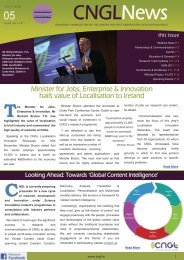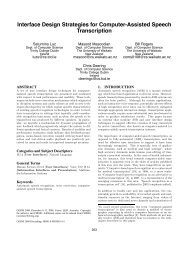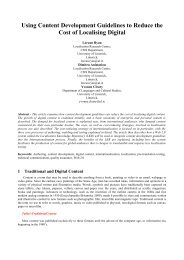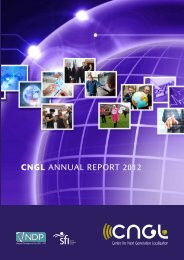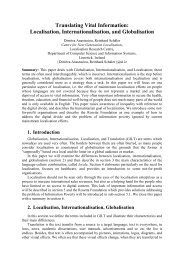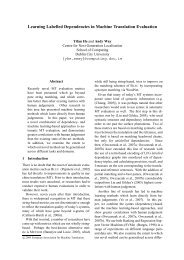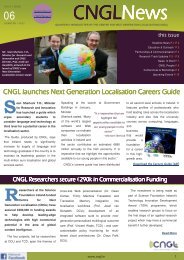Free/Open-Source Machine Translation: a three-day tutorial ... - CNGL
Free/Open-Source Machine Translation: a three-day tutorial ... - CNGL
Free/Open-Source Machine Translation: a three-day tutorial ... - CNGL
You also want an ePaper? Increase the reach of your titles
YUMPU automatically turns print PDFs into web optimized ePapers that Google loves.
(a) Description<br />
• Background (interNOSTRUM, Universia)<br />
• Rationale<br />
• Apertium as a shallow-transfer machine translation platform:<br />
engine, data, tools (Armentano et al. 2006).<br />
• Language-pair data<br />
• Funding<br />
• The Apertium community as an example of FOSS development<br />
(repositories: the trunk, the incubator; roles).<br />
• Apertium tools: apertium-dixtools, apertium-transfertools,<br />
apertium-tagger-training-tools.<br />
• Apertium-based applications (Tinylex, Wordpress plugin,<br />
Pidgin plugin, <strong>Open</strong>Office.org plugins, etc.)<br />
• Apertium as a research platform (Sánchez-Martínez and<br />
Forcada 2007, Sánchez-Martínez et al. 2008).<br />
(b) Laboratory: installing and modifying Apertium<br />
• Installing Apertium from the latest sources on a virtual<br />
Linux machine.<br />
• Changing the data for a language pair: vocabularies and,<br />
optionally, transfer rules.<br />
4. Corpus-based FOSMT: Moses (*)<br />
(a) Statistical machine translation<br />
• Statistical MT (SMT)<br />
• The data: sentence-aligned corpora.<br />
• Training: the statistical models<br />
• The SMT engine or “decoder”<br />
(b) Description of Moses and related software:<br />
• Training: Giza++<br />
• Language models: irstlm<br />
• Tuning: MERT<br />
• Decoding: Moses<br />
(c) Laboratory: installing and running Moses.<br />
4



![CNGL Annual Report 2009 [pdf - 6.5 MB]](https://img.yumpu.com/50459787/1/184x260/cngl-annual-report-2009-pdf-65-mb.jpg?quality=85)
